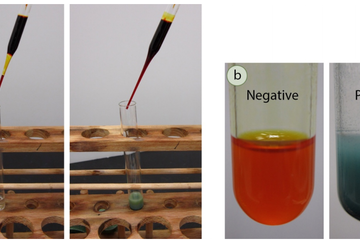We found 304 results that contain "it"
Posted on: Child Education

DISCIPLINARY CONTENT
Nature
Philosophers of science have suggested a number of criteria, including Karl Popper's controversial falsifiability criterion, to help them differentiate scientific endeavors from non-scientific ones. Validity, accuracy, and quality control, such as peer review and repeatability of findings, are amongst the most respected criteria in today's global scientific community.
ref: https://en.wikipedia.org/wiki/Natural_science
ref: https://en.wikipedia.org/wiki/Natural_science
Authored by:
Karl Popper

Posted on: Child Education


Nature
Philosophers of science have suggested a number of criteria, includ...
Authored by:
DISCIPLINARY CONTENT
Wednesday, Dec 2, 2020
Posted on: #iteachmsu

ASSESSING LEARNING
HRM Student Assignments
hired at Olympic View Elementary in 1996 and taught 6th grade primarily - during some of those years, I looped hired at Olympic View Elementary in 1996 and taught 6th grade primarily - during some of those years, I looped and taught the same students .
Authored by:
Helom
Posted on: #iteachmsu

HRM Student Assignments
hired at Olympic View Elementary in 1996 and taught 6th grade ...
Authored by:
ASSESSING LEARNING
Tuesday, Aug 11, 2020
Posted on: #iteachmsu

ASSESSING LEARNING
Chemical testing overview
Before spectroscopic analysis (IR, NMR) became commonplace in the organic chemistry lab, chemical tests were heavily relied upon to support compound identification. A chemical test is typically a fast reaction performed in a test tube that gives a dramatic visual clue (a color change, precipitate, or gas formation) as evidence for a chemical reaction. For example, addition of an orange chromic acid reagent to some compounds causes the chromium reagent to change to a blue-green color (Figure 6.37a). This is considered a "positive" test result, and in this case indicates the presence of a functional group that can be oxidized (alcohol or aldehyde). A negative test result is retention of the original color of the reagent, in this case the orange color
Authored by:
Chathuri

Posted on: #iteachmsu


Chemical testing overview
Before spectroscopic analysis (IR, NMR) became commonplace in the o...
Authored by:
ASSESSING LEARNING
Monday, Aug 26, 2019
Posted on: #iteachmsu

DISCIPLINARY CONTENT
Global commodity prices
Oil prices are expected to soften in 2020 from an average of $62 per barrel in 2019 to $58 in 2020 due to weaker demand.[xii] Supply shortages in Russia, Venezuela and the Middle East may have masked a softening this year.
The new steel and aluminum tariffs levied against Brazil and Argentina are intended to counter severe devaluations of currencies that have artificially boosted exports. Metal prices which increased 4% in 2019 are expected to drop 6% next year. Some metals such as nickel and copper have been volatile this year. However, IMF expects iron ore and nickel prices to rally. After contracting in 2019, food prices are expected to rise 2.8% in 2020.
China
The Chinese economy is also skittish, and a downturn there could precipitate a global recession.
The U.S. and China have announced agreement of a “phase-one trade” deal. While markets have responded favorably, the deal focused on U.S. agriculture exports and doesn’t move the needle for other sectors such as manufacturing. Even if a more substantive deal is reached, complex disagreement will persist – including subsidies of state-run companies and technology transfers. As we approach 2020, China is redirecting its exports to Korea, Vietnam and Mexico.
In Q3, China’s economy grew at the slowest rate in three decades as companies ratcheted back investment.[xiii] State-run companies have a return on capital that is about half of U.S. companies. There is significant movement within the Chinese economy, where the service sector now represents 46% of employment.[xiv]
The new steel and aluminum tariffs levied against Brazil and Argentina are intended to counter severe devaluations of currencies that have artificially boosted exports. Metal prices which increased 4% in 2019 are expected to drop 6% next year. Some metals such as nickel and copper have been volatile this year. However, IMF expects iron ore and nickel prices to rally. After contracting in 2019, food prices are expected to rise 2.8% in 2020.
China
The Chinese economy is also skittish, and a downturn there could precipitate a global recession.
The U.S. and China have announced agreement of a “phase-one trade” deal. While markets have responded favorably, the deal focused on U.S. agriculture exports and doesn’t move the needle for other sectors such as manufacturing. Even if a more substantive deal is reached, complex disagreement will persist – including subsidies of state-run companies and technology transfers. As we approach 2020, China is redirecting its exports to Korea, Vietnam and Mexico.
In Q3, China’s economy grew at the slowest rate in three decades as companies ratcheted back investment.[xiii] State-run companies have a return on capital that is about half of U.S. companies. There is significant movement within the Chinese economy, where the service sector now represents 46% of employment.[xiv]
Posted by:
Rohit 936 shinde

Posted on: #iteachmsu


Global commodity prices
Oil prices are expected to soften in 2020 from an average of $62 pe...
Posted by:
DISCIPLINARY CONTENT
Friday, Apr 10, 2020
Posted on: #iteachmsu

NAVIGATING CONTEXT
What is Attention Deficit Hyperactivity Disorder?
What is Attention Deficit Hyperactivity Disorder?
Classroom Interventions for Attention Deficit/ Hyperactivity Disorder Considerations Packet
Primer text from The College of William & MaryADHD is one of the most commonly diagnosed conditions of children (Centers for DiseaseControl and Prevention, 2015).
In a 2016 Centers for Disease Control and Prevention study, scientists found that 6.1 million children aged 2-17 years living in the U.S. had been diagnosed with attention-deficit/hyperactivity disorder (ADHD), which is similar to previous en
Ages 6-11: Approximately 2.4 million children
Ages 12-17: Approximately 3.3 million children
The diagnostic term attention deficit/hyperactivity disorder (ADHD) refers to individuals who display patterns of inattention, impulsivity, and overactive behavior that interfere with daily functioning (American Psychiatric Association [APA], 2013).
The Diagnostic and Statistical Manual (DSM) V (APA, 2013) criteria for diagnosing ADHD listthree types of ADHD and the accompanying characteristics.
The student may:o Appear to be in constant motion,o frequently fidget or move in his or her seat,o become restless during quiet activities,o leave his or her seat when expected to remain seated,o interrupt others and classroom activities,o talk excessively, and/oro fail to follow classroom procedures (e.g., blurt out answers without raising hand).
Combined type. The student may exhibit symptoms that include behaviors from both categories above.
In order for a student to be diagnosed with ADHD, symptoms must appear before age 12 and be exhibited across at least two settings. They must also have adverse effects on academic performance, occupational success, or social-emotional development (APA, 2013).
To add to the complexity of the diagnosis, children with ADHD are likely to have co-existing emotional, behavioral, developmental, learning, or physical conditions (Wolraich & DuPaul, 2010).
Classroom Interventions for Attention Deficit/ Hyperactivity Disorder Considerations Packet
Primer text from The College of William & MaryADHD is one of the most commonly diagnosed conditions of children (Centers for DiseaseControl and Prevention, 2015).
In a 2016 Centers for Disease Control and Prevention study, scientists found that 6.1 million children aged 2-17 years living in the U.S. had been diagnosed with attention-deficit/hyperactivity disorder (ADHD), which is similar to previous en
Ages 6-11: Approximately 2.4 million children
Ages 12-17: Approximately 3.3 million children
The diagnostic term attention deficit/hyperactivity disorder (ADHD) refers to individuals who display patterns of inattention, impulsivity, and overactive behavior that interfere with daily functioning (American Psychiatric Association [APA], 2013).
The Diagnostic and Statistical Manual (DSM) V (APA, 2013) criteria for diagnosing ADHD listthree types of ADHD and the accompanying characteristics.
The student may:o Appear to be in constant motion,o frequently fidget or move in his or her seat,o become restless during quiet activities,o leave his or her seat when expected to remain seated,o interrupt others and classroom activities,o talk excessively, and/oro fail to follow classroom procedures (e.g., blurt out answers without raising hand).
Combined type. The student may exhibit symptoms that include behaviors from both categories above.
In order for a student to be diagnosed with ADHD, symptoms must appear before age 12 and be exhibited across at least two settings. They must also have adverse effects on academic performance, occupational success, or social-emotional development (APA, 2013).
To add to the complexity of the diagnosis, children with ADHD are likely to have co-existing emotional, behavioral, developmental, learning, or physical conditions (Wolraich & DuPaul, 2010).
Posted by:
Archana Chaurasia

Posted on: #iteachmsu


What is Attention Deficit Hyperactivity Disorder?
What is Attention Deficit Hyperactivity Disorder?
Classroom Interv...
Classroom Interv...
Posted by:
NAVIGATING CONTEXT
Friday, Feb 17, 2023
Posted on: #iteachmsu

ASSESSING LEARNING
Critical Component #2: Thoughtful Classroom Setup and Structure
Skilled educators accept responsibility for planning and delivering instruction that brings the five critical components described below to life for all learners.
At times, external factors beyond the classroom walls will affect an educator’s ability to sustain all five critical components. Skilled educators find ways wherever possible to ensure that these five critical components are present in all aspects of classroom culture.
At times, external factors beyond the classroom walls will affect an educator’s ability to sustain all five critical components. Skilled educators find ways wherever possible to ensure that these five critical components are present in all aspects of classroom culture.
Posted by:
Scarlet Ethan Edien

Posted on: #iteachmsu


Critical Component #2: Thoughtful Classroom Setup and Structure
Skilled educators accept responsibility for planning and delivering...
Posted by:
ASSESSING LEARNING
Wednesday, Mar 10, 2021
Posted on: #iteachmsu

Artificial Intelligence Modelling Language. AIML is an XML based markup language
AIML stands for Artificial Intelligence Markup Language. AIML was developed by the Alicebot free software community and Dr. Richard S. Wallace during 1995-2000. AIML is used to create or customize Alicebot which is a chat-box application based on A.L.I.C.E. (Artificial Linguistic Internet Computer Entity) free software.
AIML Tags
Following are the important tags which are commonly used in AIML documents.
S.No.
AIML Tag / Description
1
<aiml>
Defines the beginning and end of a AIML document.
2
<category>
Defines the unit of knowledge in Alicebot's knowledge base.
3
<pattern>
Defines the pattern to match what a user may input to an Alicebot.
4
<template>
Defines the response of an Alicebot to user's input.
We'll discuss each of these tags in AIML Basic tags chapter.
Following are some of the other widely used aiml tags. We'll be discussing each tag in details in coming chapters.
S.No.
AIML Tag / Description
1
<star>
Used to match wild card * character(s) in the <pattern> Tag.
2
<srai>
Multipurpose tag, used to call/match the other categories.
3
<random>
Used <random> to get random responses.
4
<li>
Used to represent multiple responses.
5
<set>
Used to set value in an AIML variable.
6
<get>
Used to get value stored in an AIML variable.
7
<that>
Used in AIML to respond based on the context.
8
<topic>
Used in AIML to store a context so that later conversation can be done based on that context.
9
<think>
Used in AIML to store a variable without notifying the user.
10
<condition>
Similar to switch statements in programming language. It helps ALICE to respond to matching input.
AIML Vocabulary
AIML vocabulary uses words, space and two special characters * and _ as wild cards. AIML interpreter gives preference to pattern having _ than pattern having *. AIML tags are XML compliant and patterns are case-insensitive.
Example
<aiml version = "1.0.1" encoding = "UTF-8"?>
<category>
<pattern> HELLO ALICE </pattern>
<template>
Hello User!
</template>
</category>
</aiml>
Following are the important points to be considered −
<aiml> tag signifies start of the AIML document.
<category> tag defines the knowledge unit.
<pattern> tag defines the pattern user is going to type.
<template> tag defines the response to the user if user types Hello Alice.
Result
User: Hello Alice
Bot: Hello User
AIML Tags
Following are the important tags which are commonly used in AIML documents.
S.No.
AIML Tag / Description
1
<aiml>
Defines the beginning and end of a AIML document.
2
<category>
Defines the unit of knowledge in Alicebot's knowledge base.
3
<pattern>
Defines the pattern to match what a user may input to an Alicebot.
4
<template>
Defines the response of an Alicebot to user's input.
We'll discuss each of these tags in AIML Basic tags chapter.
Following are some of the other widely used aiml tags. We'll be discussing each tag in details in coming chapters.
S.No.
AIML Tag / Description
1
<star>
Used to match wild card * character(s) in the <pattern> Tag.
2
<srai>
Multipurpose tag, used to call/match the other categories.
3
<random>
Used <random> to get random responses.
4
<li>
Used to represent multiple responses.
5
<set>
Used to set value in an AIML variable.
6
<get>
Used to get value stored in an AIML variable.
7
<that>
Used in AIML to respond based on the context.
8
<topic>
Used in AIML to store a context so that later conversation can be done based on that context.
9
<think>
Used in AIML to store a variable without notifying the user.
10
<condition>
Similar to switch statements in programming language. It helps ALICE to respond to matching input.
AIML Vocabulary
AIML vocabulary uses words, space and two special characters * and _ as wild cards. AIML interpreter gives preference to pattern having _ than pattern having *. AIML tags are XML compliant and patterns are case-insensitive.
Example
<aiml version = "1.0.1" encoding = "UTF-8"?>
<category>
<pattern> HELLO ALICE </pattern>
<template>
Hello User!
</template>
</category>
</aiml>
Following are the important points to be considered −
<aiml> tag signifies start of the AIML document.
<category> tag defines the knowledge unit.
<pattern> tag defines the pattern user is going to type.
<template> tag defines the response to the user if user types Hello Alice.
Result
User: Hello Alice
Bot: Hello User
Authored by:
AIML stands for Artificial Intelligence Modelling Languag...

Posted on: #iteachmsu

NAVIGATING CONTEXT
What is Attention Deficit Hyperactivity Disorder?
What is Attention Deficit Hyperactivity Disorder?
Classroom Interventions for Attention Deficit/ Hyperactivity Disorder Considerations Packet
Primer text from The College of William & MaryADHD is one of the most commonly diagnosed conditions of children (Centers for DiseaseControl and Prevention, 2015).
In a 2016 Centers for Disease Control and Prevention study, scientists found that 6.1 million children aged 2-17 years living in the U.S. had been diagnosed with attention-deficit/hyperactivity disorder (ADHD), which is similar to previous en
Ages 6-11: Approximately 2.4 million children
Ages 12-17: Approximately 3.3 million children
The diagnostic term attention deficit/hyperactivity disorder (ADHD) refers to individuals who display patterns of inattention, impulsivity, and overactive behavior that interfere with daily functioning (American Psychiatric Association [APA], 2013).
The Diagnostic and Statistical Manual (DSM) V (APA, 2013) criteria for diagnosing ADHD listthree types of ADHD and the accompanying characteristics.
The student may:o Appear to be in constant motion,o frequently fidget or move in his or her seat,o become restless during quiet activities,o leave his or her seat when expected to remain seated,o interrupt others and classroom activities,o talk excessively, and/oro fail to follow classroom procedures (e.g., blurt out answers without raising hand).
Combined type. The student may exhibit symptoms that include behaviors from both categories above.
In order for a student to be diagnosed with ADHD, symptoms must appear before age 12 and be exhibited across at least two settings. They must also have adverse effects on academic performance, occupational success, or social-emotional development (APA, 2013).
To add to the complexity of the diagnosis, children with ADHD are likely to have co-existing emotional, behavioral, developmental, learning, or physical conditions (Wolraich & DuPaul, 2010).
Classroom Interventions for Attention Deficit/ Hyperactivity Disorder Considerations Packet
Primer text from The College of William & MaryADHD is one of the most commonly diagnosed conditions of children (Centers for DiseaseControl and Prevention, 2015).
In a 2016 Centers for Disease Control and Prevention study, scientists found that 6.1 million children aged 2-17 years living in the U.S. had been diagnosed with attention-deficit/hyperactivity disorder (ADHD), which is similar to previous en
Ages 6-11: Approximately 2.4 million children
Ages 12-17: Approximately 3.3 million children
The diagnostic term attention deficit/hyperactivity disorder (ADHD) refers to individuals who display patterns of inattention, impulsivity, and overactive behavior that interfere with daily functioning (American Psychiatric Association [APA], 2013).
The Diagnostic and Statistical Manual (DSM) V (APA, 2013) criteria for diagnosing ADHD listthree types of ADHD and the accompanying characteristics.
The student may:o Appear to be in constant motion,o frequently fidget or move in his or her seat,o become restless during quiet activities,o leave his or her seat when expected to remain seated,o interrupt others and classroom activities,o talk excessively, and/oro fail to follow classroom procedures (e.g., blurt out answers without raising hand).
Combined type. The student may exhibit symptoms that include behaviors from both categories above.
In order for a student to be diagnosed with ADHD, symptoms must appear before age 12 and be exhibited across at least two settings. They must also have adverse effects on academic performance, occupational success, or social-emotional development (APA, 2013).
To add to the complexity of the diagnosis, children with ADHD are likely to have co-existing emotional, behavioral, developmental, learning, or physical conditions (Wolraich & DuPaul, 2010).
Posted by:
Archana Chaurasia

Posted on: #iteachmsu


What is Attention Deficit Hyperactivity Disorder?
What is Attention Deficit Hyperactivity Disorder?
Classroom Interv...
Classroom Interv...
Posted by:
NAVIGATING CONTEXT
Friday, Feb 17, 2023


